Mastering Gourmet Cooking: Key Techniques Revealed
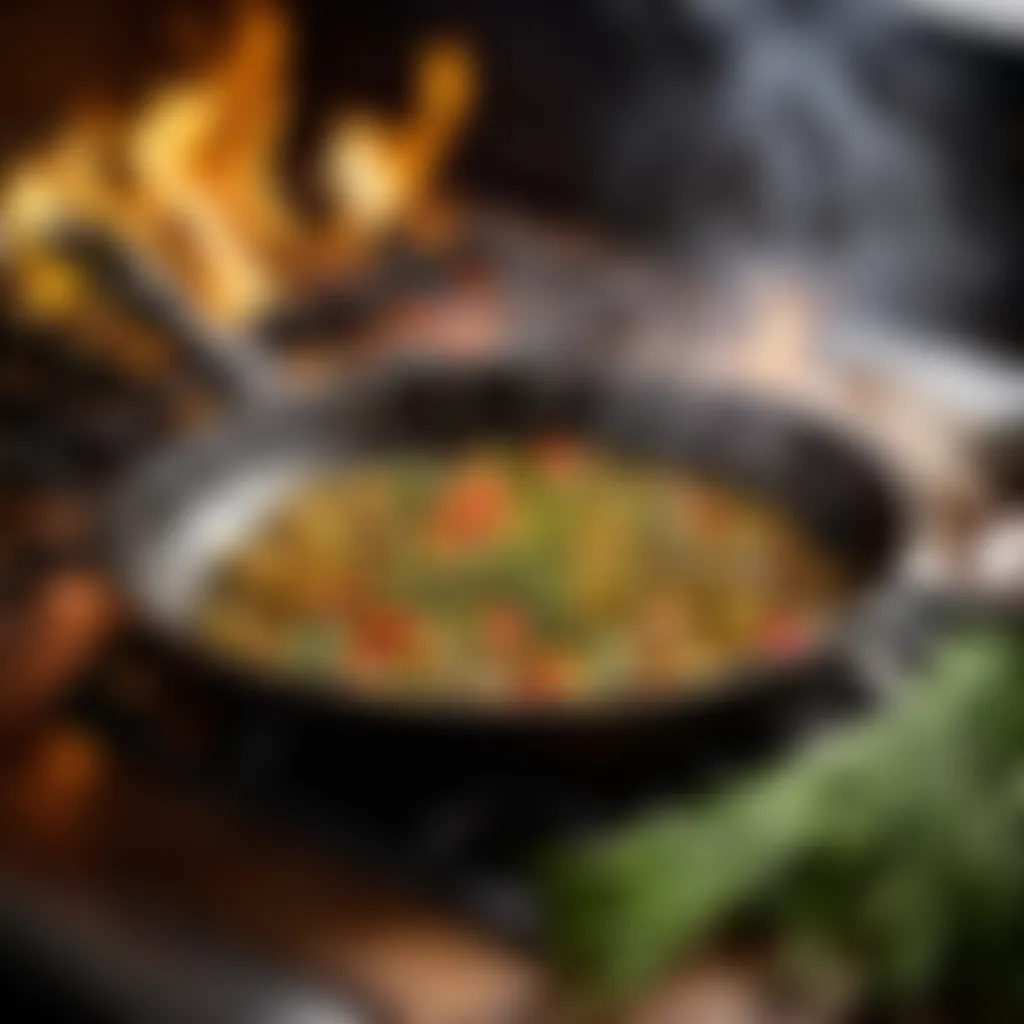
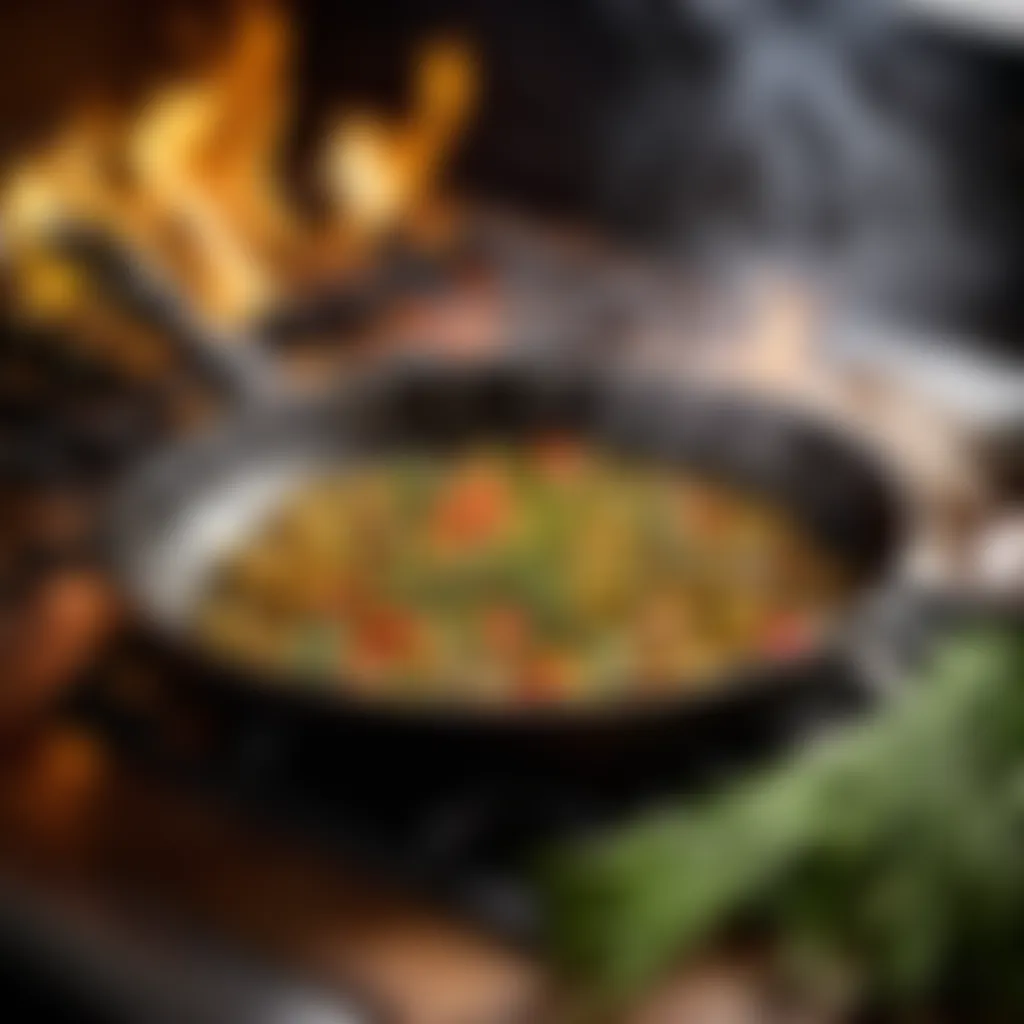
Intro
Diving into the world of gourmet cooking is nothing short of a delicious adventure. With every slice, sprinkle, and sauté, you have the chance to unlock a treasure trove of flavors and techniques that can elevate your dishes from mundane to magnificent. The heart of gourmet cooking lies in mastering essential kitchen techniques. With the right skills and a sprinkling of creativity, every home cook can transform a simple meal into an exquisite masterpiece.
This journey begins with understanding the foundational ingredients that make up your culinary canvas. It’s crucial to approach cooking with a clear plan. Every little detail matters—right from selecting top-notch ingredients to perfectly timing your cooking methods. Each step brings you closer to culinary mastery.
Whether you’re a busy housewife looking to impress your family or simply wanting to refine your cooking prowess, knowing the essential techniques and approaches is the key to stride confidently through your kitchen. Now, let’s roll up those sleeves and start from the very beginning.
Understanding Gourmet Cooking
Culinary craftsmanship is an intricate art form. Understanding gourmet cooking is more than just knowing how to follow a recipe. It's about elevating the ordinary to the extraordinary by mastering select techniques and employing them with precision. This is crucial in the journey toward culinary mastery, as it lays down the foundation upon which all gourmet dishes are built.
To truly grasp the essence of gourmet cooking, one must delve into its philosophy, which emphasizes quality ingredients, refined techniques, and a meticulous approach to food presentation. This understanding not only enhances the cooking experience but also transforms the way one perceives food in general.
Imagine busting out the grill and presenting a perfectly seared steak that’s as pleasing to the eye as it is to the palate. These are rewards of gaining knowledge in gourmet techniques. It's about the marriage of flavors and textures that tickle the taste buds while making the meal visually appealing. Understand that every slice, every sprinkle of seasoning, and every cooking method you choose plays a pivotal role in achieving a gourmet experience.
Defining Gourmet Cooking
Gourmet cooking can be defined as a style of cooking that emphasizes high-quality ingredients and sophisticated techniques to create exceptional dishes. While most people might think gourmet meals are only served in upscale restaurants, the reality is that you can bring this caliber of cuisine into your own home. It’s essential to understand that being a gourmet cook isn’t about snobbery; it’s about passion for the craft.
Not limited to high price tags or elaborate presentations, gourmet cooking can manifest in simplicity too. A humble vegetable soup, when prepared with seasonal ingredients and respect for technique, can provide a gourmet experience. It's about making the most of what you have and transforming it into something remarkable.
The Importance of Technique
The backbone of gourmet cooking is technique. Mastering foundational techniques not only affects the outcome but also boosts confidence in the kitchen. Techniques such as julienning vegetables, emulsifying dressings, or creating a beurre blanc sauce can elevate home-cooked meals into a fine dining experience.
Employing the right techniques allows for better flavor extraction and texture manipulation. For instance, the art of searing meat isn’t just to create a pleasing exterior; it enhances the depth of flavor, setting the stage for subsequent cooking methods.
"A skilled hand can take a simple dish and turn it into a feast. It’s all about knowing what to do and when to do it."
Essential Tools for the Gourmet Kitchen
When it comes to whipping up gourmet dishes, one mustn't underestimate the weight of essential tools in the kitchen. Just like how a painter relies on his brushes, a gourmet cook depends on a cadre of specialized utensils. These tools not only facilitate a smoother cooking process but also empower the home cook to experiment, innovate, and ultimately craft remarkable culinary creations.
First and foremost, the quality of tools impacts the outcome of any dish. Using the right knife, for example, can mean the difference between a finely julienned carrot and a raggedy mess. Likewise, having the correct cookware can elevate a simple stir-fry into a vibrant masterpiece. Each piece not only carries practical benefits but imbues the act of cooking with a sense of professionalism and artistry.
Here are some specific elements to consider when curating your gourmet toolkit:
- Durability: Cheap tools may lead to frustration and unhappiness. Investing in high-end tools may sound excessive, but they last much longer, making them cost-effective in the long run.
- Versatility: Tools that serve multiple purposes can save you both space and money. For instance, a good cast-iron skillet is a multitasker, performing well from stovetop to oven.
- Ergonomics: Comfort is key when you’re spending time in the kitchen. Ergonomically designed handles and easy-to-grip surfaces can save your hands from tire and strain.
In summary, the right kitchen tools can transform your culinary endeavors from mundane to extraordinary. Let's delve deeper into specific tools that every aspiring gourmet chef should consider.
Knives: The Chef's Best Friend
Knives rank supreme in the hierarchy of kitchen tools. They are, without a doubt, the most essential weapon in a chef's arsenal. A good knife makes prep work faster, more efficient, and dare I say, enjoyable. There are several types of knives that one should be familiar with:
- Chef's Knife: The workhorse of the kitchen. This versatile blade can slice, dice, and chop just about anything.
- Paring Knife: Ideal for peeling and intricate work. It’s smaller, offering control for delicate tasks.
- Serrated Knife: Perfect for bread and tomatoes, its saw-like edge allows for seamless slicing without squashing.
Maintaining your knives also requires special attention. Regular honing keeps the blades sharp, and occasional professional sharpening can ensure their longevity.
"A dull knife is more dangerous than a sharp knife; it requires more force to cut, leading to accidents."
Cookware: Selecting the Right Vessel
Selecting appropriate cookware is pivotal in executing culinary techniques correctly. Different types of cookware respond uniquely to heat, hence affecting both cooking times and flavors. Here are some key categories:
- Stainless Steel: Non-reactive and durable, best for browning and pan sauces.
- Non-stick: Handy for delicate items like eggs and pancakes; however, it’s not ideal for high-heat methods.
- Cast Iron: Perfect for frying and baking due to its heat retention properties.
- Copper: Offers remarkable heat conductivity, allowing for precise temperature control.
When investing in cookware, consider the materials' compatibility with your cooking style and preferences. It’s also vital to know the care guidelines; for instance, while cast iron can last a lifetime, neglecting proper seasoning can lead to rust and deterioration.
Cutting Boards: Materials and Maintenance
A cutting board serves as your primary workspace, so choosing the right material can greatly influence your cooking experience. Here are common types:
- Wooden Boards: Gentle on knife edges and aesthetically pleasing, but they require regular oiling to maintain.
- Plastic Boards: Lightweight and dishwasher-safe, they can handle raw meats without absorbing flavors.
- Bamboo Boards: Eco-friendly and still sturdy; however, they can be tougher on knives than wood.
Maintenance is equally important. Always wash your boards after use and try to keep separate boards for raw meats and vegetables to avoid cross-contamination. Oil wooden boards regularly to keep them in top shape.
Fundamentals of Food Preparation
The process of preparing food lays the groundwork for creating a truly memorable gourmet dish. In the world of culinary arts, the phrase "fundamentals of food preparation" encapsulates essential practices that ensure not only the success of a dish but also the enjoyment of cooking itself. Mastering these fundamentals provides several advantages: it streamlines processes, enhances flavors, and paves the way for creativity in the kitchen. Each component from organization to technique carries weight in the end result; thus, understanding these elements is crucial for anyone looking to elevate their culinary skills.


Mise en Place: Organizing for Success
"Mise en place", a French term translating to "everything in its place," embodies the foundation of effective food preparation. This practice is all about organization, where each ingredient is prepped and ready before diving into the actual cooking process. Creating a prepared workspace not only reduces stress, but also increases efficiency.
Consider the following benefits of adopting mise en place:
- Efficiency: With all ingredients prepped, chefs can focus solely on the cooking rather than scrambling for what’s needed next.
- Cohesion: This structured setup helps to maintain a natural flow in cooking, allowing one step to seamlessly lead to another without interrupting progress.
- Reduced Waste: When every element is organized beforehand, it’s easier to visualize quantities needed, potentially minimizing excess.
On a practical level, establishing mise en place often involves chopping vegetables, measuring spices, and arranging everything neatly on the counter. It’s not just about getting ready to cook; it’s a mindset that fosters culinary confidence and precision.
Essential Cutting Techniques
Mastering essential cutting techniques is indispensable for any aspiring gourmet cook. Good knife skills enhance texture and appearance, while also contributing to even cooking. Here are some fundamental cutting techniques every cook should know:
- Julienne: This involves cutting ingredients into thin, matchstick-sized strips for an appealing presentation.
- Chop: A more straightforward technique that incorporates cutting food into uniform pieces, ensuring even cooking.
- Mince: Ideal for herbs or garlic, mincing creates tiny pieces that release intense flavors rapidly during cooking.
Each technique demands practice, but the rewards are manifold. An added advantage of honing these skills is safety; a well-cut, uniform piece reduces the likelihood of slipping, hence protecting the cook's fingers!
Marinating and Seasoning
A good marination and seasoning process can turn an ordinary dish into an extraordinary feast. Marinating not only enhances flavor but also can tenderize proteins, setting the stage for sumptuous meals.
Here’s how to marinade effectively:
- Types of Marinades: Use acidic (like vinegar or citrus juice), enzymatic (like pineapple or papaya), or oil-based marinades to break down tougher protein fibers.
- Timing is Key: Different proteins require various marination times; for example, fish absorbs flavor quickly, needing only 30 minutes, while tougher cuts of meat benefit from slow marination, between hours to overnight.
Seasoning is equally important. It’s about balance between the base flavors of sweet, sour, salty, and bitter. The strategic use of herbs and spices brings out the best in any dish. A pinch of salt enhances sweetness, while a splash of acid can brighten rich flavors.
Embrace variations to develop a personal touch. Not every dish demands the same seasoning; be adventurous, and don’t shy away from experimenting.
Ultimately, understanding and applying these fundamentals of food preparation will not only enhance the savory experience in the kitchen but also nurture confidence, leading to continuous exploration and enjoyment in gourmet cooking.
Cooking Methods: Elevating Flavor and Technique
Cooking methods are at the heart of gourmet cuisine. They can single-handedly transform a simple ingredient into an extraordinary dish. Each method brings its own flavor, texture, and character to the plate. By mastering these techniques, cooks can enhance their culinary repertoire and deliver meals that not only satisfy but also impress.
Several factors come into consideration when choosing a cooking method, including the type of food, desired outcome, and available equipment. Understanding how various methods interact with key ingredients will allow cooks to unlock the full potential of any dish. Furthermore, different techniques can be combined to layer flavors and create complex taste experiences that are synonymous with gourmet cooking.
Searing: Creating Depth of Flavor
Searing is a foundational technique that introduces a rich, caramelized flavor to meats and vegetables. The high heat leads to the Maillard reaction, which is where the magic happens, as it gives that desirable crust and complex taste. Whether you are cooking a steak or preparing delicate fish, adequate heat and timing are essential.
- Use a heavy pan: Cast iron or stainless steel pans are ideal as they retain heat well.
- Pat the food dry: This helps achieve a proper sear by reducing moisture.
- Do not overcrowd the pan: Give each piece ample space to breathe; otherwise, it will steam rather than sear.
Experimenting with marinades can also add layers to the sear. Try savory spices or herb-infused oils for an extra punch.
Sous Vide: Precision Cooking
Sous vide is a game-changer in the kitchen, providing unparalleled control over cooking temperatures. The process involves vacuum-sealing food and cooking it in a water bath at a precisely regulated temperature. This method results in perfectly cooked proteins every time.
- Consistent results: No more guessing if the chicken is done; sous vide guarantees a tender and juicy outcome.
- Flavors meld: The vacuum-sealed environment allows marinades and seasonings to fully penetrate the food, enhancing flavors.
- Time flexibility: Sous vide can offer extended cooking times without compromising quality, allowing for multitasking in the kitchen.
For those looking to dabble in sous vide, investing in a quality immersion circulator is a wise move.
Poaching: The Gentle Method
Poaching is often overlooked as a cooking method, yet it produces delicate dishes that shine in their simplicity. Cooking food in a simmering liquid, such as stock, wine, or water, allows it to retain moisture while absorbing flavors.
- Perfect for delicate items: Eggs, fish, and fruits all benefit from this gentle approach.
- Healthier option: There’s no need for added fat, making it a lighter choice.
- Controlled flavoring: Infusing the poaching liquid with herbs and aromatics elevates the dish remarkably.
Remember to monitor the temperature carefully; it should never boil, as this would break the food apart.
Braising: Building Layers of Taste
Braising is an exquisite technique that melds flavors over time. Best suited for tougher cuts of meat or hearty vegetables, this method combines two techniques: first searing to develop color and flavor, then cooking slowly in liquid.
- Depth of flavor: The initial sear enhances the dish’s overall richness, while the slow cooking allows for a harmonious blend of tastes.
- Flexible one-pot dish: Everything can cook together in the same pot, merging distinct flavors and creating a comforting meal.
- Adaptability: Use a variety of liquids—such as broth, wine, or even fruit juice—to create diverse flavor profiles.
Epilogue
Mastering these cooking methods equips gourmet cooks with the tools to achieve profound flavor and texture in their dishes. From the robust crust of a seared steak to the intricate intertwining of flavors in a braised dish, these techniques allow for creativity and precision in the kitchen. Embrace the art of cooking by exploring each method, and don’t shy away from combining them to create masterpieces on your dinner table.
Plating and Presentation
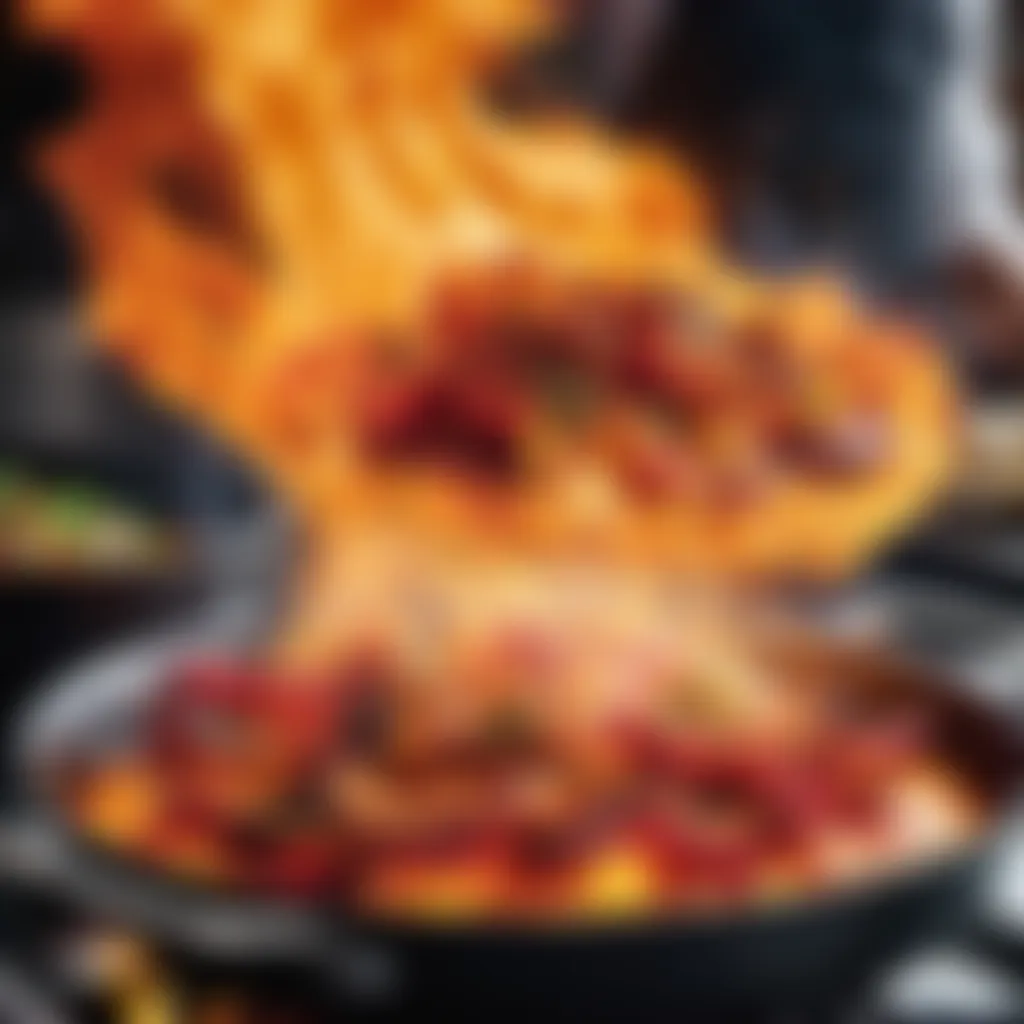

Plating and presentation are often the unsung heroes in the culinary world. They are the finishing touches that transform a meal from mere sustenance to a visual feast. Well-executed plating can elevate even the simplest dish, making it enticing and memorable. In gourmet cooking, the way a dish is presented speaks volumes about the chef's intention and creativity. It's not just about putting food on a plate; it's about curating an experience that engages all the senses.
When we plate a dish, we engage with aesthetics and expressions of flavor and texture. The arrangement of the food influences not only its appeal but also how it is perceived when tasted. There’s a certain psychology involved; a beautifully plated dish can enhance appreciation for flavors not just by sight but also by expectation. A thoughtful presentation invites diners to take a moment before indulging, creating anticipation.
The Art of Plating
Plating is considered an art form by many chefs and culinary enthusiasts. It’s where technique meets creativity, giving you ample room to express creativity. From the choice of dishes to the final drizzling of sauces, every element counts.
- Choose Your Plate Wisely: Different plate shapes and sizes can drastically affect how the food looks. A wide, shallow plate may work wonders for a salad, where height and color can shine through, while a deep bowl might be more suitable for a creamy pasta.
- The Components: Think of your meal in terms of single ingredients and how they can be combined. For instance, in a medley of roasted vegetables, consider the shapes and colors. Cut them in various ways; this not only adds visual intrigue but also enhances the dining experience.
- Layering and Height: Create dimensions by building height. This can be achieved using tower-like structures or stacking components. For example, stacking a protein atop a bed of vegetables can take a straightforward meal to another level.
- Garnishes and Sauces: Don’t underestimate the power of a good garnish. Fresh herbs, edible flowers, or zesty microgreens can bring a burst of color and flavor. Additionally, playing with sauce placement - drizzling it around the plate rather than just atop - creates a more dynamic look.
It is essential to remember that the act of plating is subjective, reflecting personal style. Experimenting is key, and finding what resonates with you and your diners is part of the journey.
Color and Texture: Aesthetic Considerations
When it comes to plating, color and texture are two cornerstones to consider. They not only heighten visual appeal but can also significantly impact flavor perception.
- Color Harmony: Utilize contrasting colors to make particular elements stand out. For instance, a bright green dish can be complemented beautifully with hues of red or orange. Think of color as a way to narrate the story of your dish.
- Texture Contrast: The interplay of textures can also lead to a more flavorful experience. A creamy sauce serves as a wonderful base for crunchier components, such as toasted nuts or crispy shallots. This approach creates a mouthfeel that keeps diners engaged.
Balancing these aspects is crucial. Too much clutter can overwhelm, while a minimalistic approach may leave dishes looking bare. Finding that sweet spot often leads to the most visually appealing results.
"The beauty of food lies not just in its taste but in how it is presented, turning a meal into an art form that tells a story."
The journey of plating and presentation opens new pathways for culinary creativity. As you refine this skill, remember that practice makes perfect. Take your time, play around with different ideas, and your skills will continue to blossom.
Understanding Flavor Profiles
Flavor profiles are the backbone of any gourmet dish. By grasping the intricacies of flavors, you can transform a simple meal into a culinary masterpiece. It’s like painting; each hue complements the other, resulting in a vibrant artwork on the plate. Understanding different flavors—how they interact, clash, or harmonize—enables cooks to elevate dishes by creating more complex and satisfying flavors. Not only does it enhance the taste, but it also opens up avenues for creativity in cooking.
Balancing Sweet, Sour, Salty, and Bitter
In the kitchen, balancing sweet, sour, salty, and bitter is akin to getting the right notes in a symphony. Each element plays an important role, contributing to the overall dish's harmony.
- Sweetness, often provided by sugars, fruits, or honey, can help to mitigate bitterness and acidity. Think of a honey glaze on grilled vegetables; it enhances while tempering sharp flavors.
- Sourness, found in lemon juice, vinegar, or yogurt, can brighten dishes, providing a refreshing counterpoint to rich flavors. A splash of lemon in a creamy risotto can lift the entire dish.
- Saltiness, crucial in enhancing flavor, must be used with care. Sea salt or kosher salt can intensify other flavors, bringing forth the dish’s true character.
- Bitterness, although often overlooked, adds depth. Foods like chicory or bitter greens can provide a significant counterbalance to sweetness and sourness, creating a more complex flavor profile.
"The art of flavor balancing is a dance where each ingredient must know its role. A successful balance can make or break the dish."
The Role of Herbs and Spices
Herbs and spices are the magical feathers in the cap of gourmet cooking. These ingredients not only add flavor but also bring a unique character to dishes. Each herb or spice has its own distinct profile, contributing nuances that can turn the ordinary into the extraordinary.
- Fresh herbs, such as basil, cilantro, or parsley, can provide a burst of freshness and color. They should typically be added towards the end of cooking to preserve their vibrant aromas.
- Dried spices, like cumin, paprika, or turmeric, bring depth. They ought to be added early in the cooking process, allowing their flavors to infuse into the dish.
- Balance is key; a touch of spice can awaken the palate, while a heavy hand might overwhelm the dish.
For instance, when cooking a tomato sauce, a dash of oregano or a pinch of crushed red pepper can truly set off the flavor combinations. Knowing when to use which herb or spice is fundamental in mastering the art of flavor.
Exploring flavors, herbs, and spices, along with understanding their interactions is essential for any aspiring chef. It shapes the way we build meals and ultimately how we experience them. Introducting these principles into your cooking will spark creativity and elevate your time in the kitchen.
Garnishing: Enhancing Dishes with Finesse
Garnishing is often the final touch in the culinary process, a delicate brushstroke on the canvas of a gourmet dish. It's not merely about making food look pretty; garnishing serves multiple purposes. It can enhance the dish's flavor, provide contrasting textures, and even amplify the overall dining experience. The right garnish can elevate a meal from simple to strikingly sophisticated, turning a plate of food into an object of art. When we take the time to garnish properly, it shows our commitment to not only satisfying the palate but also delighting the eyes.
"A dish well garnished is like a dress worn by a prince; it attracts admiration and enhances the overall quality of what lies beneath."
Selecting the Right Garnish
Choosing the perfect garnish hinges on several factors. Firstly, consider the flavors and textures of the dish. A sprinkle of fresh herbs, such as cilantro or parsley, brings a bright freshness that can complement rich sauces or meats. On the other hand, crunchy elements like toasted nuts or seeds can add texture to creamy dishes, creating a delightful contrast.
Next, aesthetics also play a critical role. A garnish should not only pair well with the dish but should also enhance the overall presentation. For instance, a vibrant red cherry tomato can pop beautifully against a green basil pesto. At times, color is more than just eye candy; it can evoke emotions and signals different taste sensations.
When selecting garnishes, consider these elements:
- Freshness: Herbs should be fresh—not wilted or brown. The difference can be night and day.
- Complementarity: The garnish should echo the dish's primary flavor without overwhelming it. For instance, a hint of lemon zest atop creamy risotto can brighten the flavors.
- Proportion: A sprinkle of microgreens can have a monumental effect, whereas a heavy-handed garnish may mask the essence of the dish.
Techniques for Garnishing
Mastering the art of garnishing involves various techniques that can be surprisingly simple yet impactful. Here are a few ideas to consider:
- Chiffonade: This technique involves stacking herbs, rolling them tightly, and slicing them into thin ribbons. It’s a great way to enhance dishes with aromatic herbs without overpowering them.
- Zesting: Using a zester to grate the skin of citrus fruits can add both flavor and a splash of color to dishes. It animates salads or desserts, providing freshness that brings everything together.
- Drizzling: A light drizzle of balsamic reduction or infused oils around a plate can frame the dish beautifully and provide a flavor boost.
- Edible Flowers: These are rising stars in the garnishing world. They’re not only visually striking, but they can also bring nuanced flavors.
- Stacking: For dishes that allow height, arrange ingredients such as layered vegetables or delicate proteins in an artful, vertical presentation.
In the end, garnishing is about playing with presentation while enhancing the flavor experience. Following these tips and techniques will help elevate your culinary prowess and impress your guests, turning any meal into an experience that tantalizes all the senses.
The Role of Time and Temperature
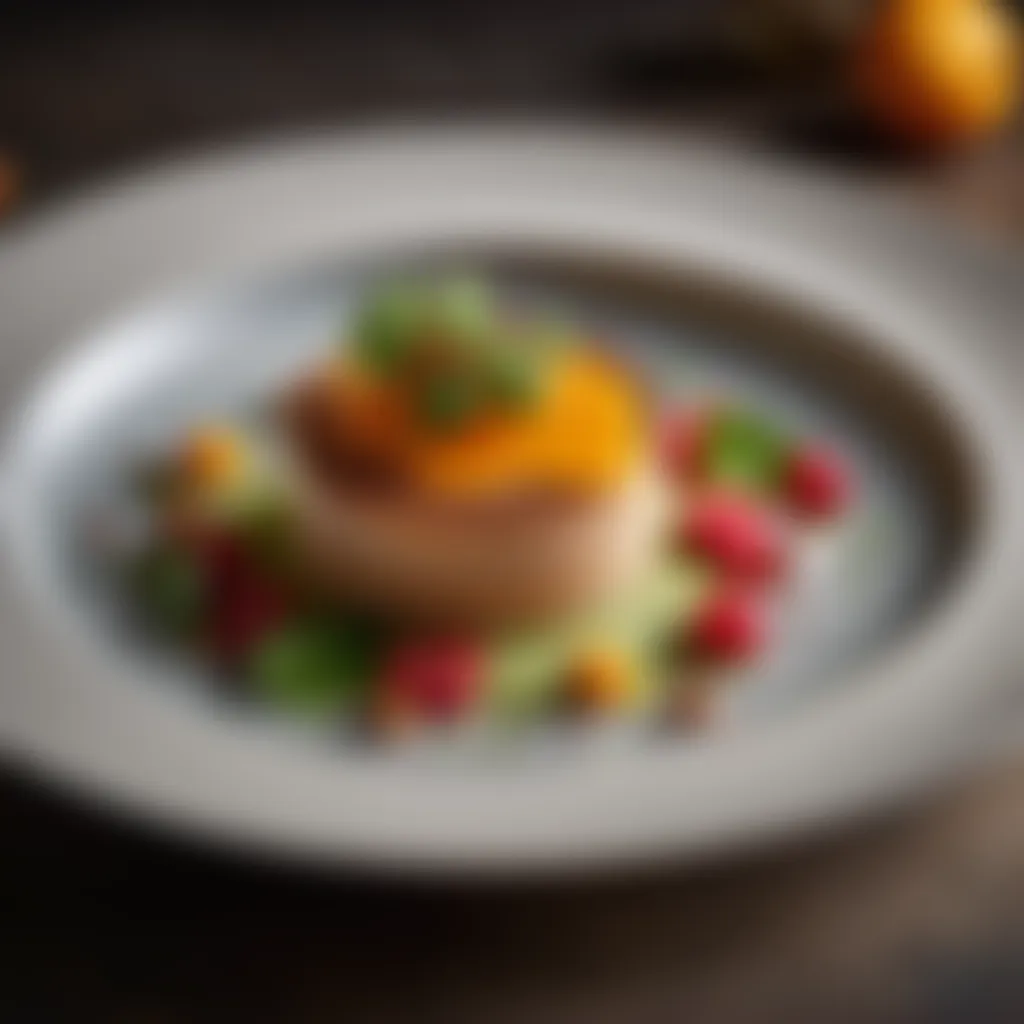
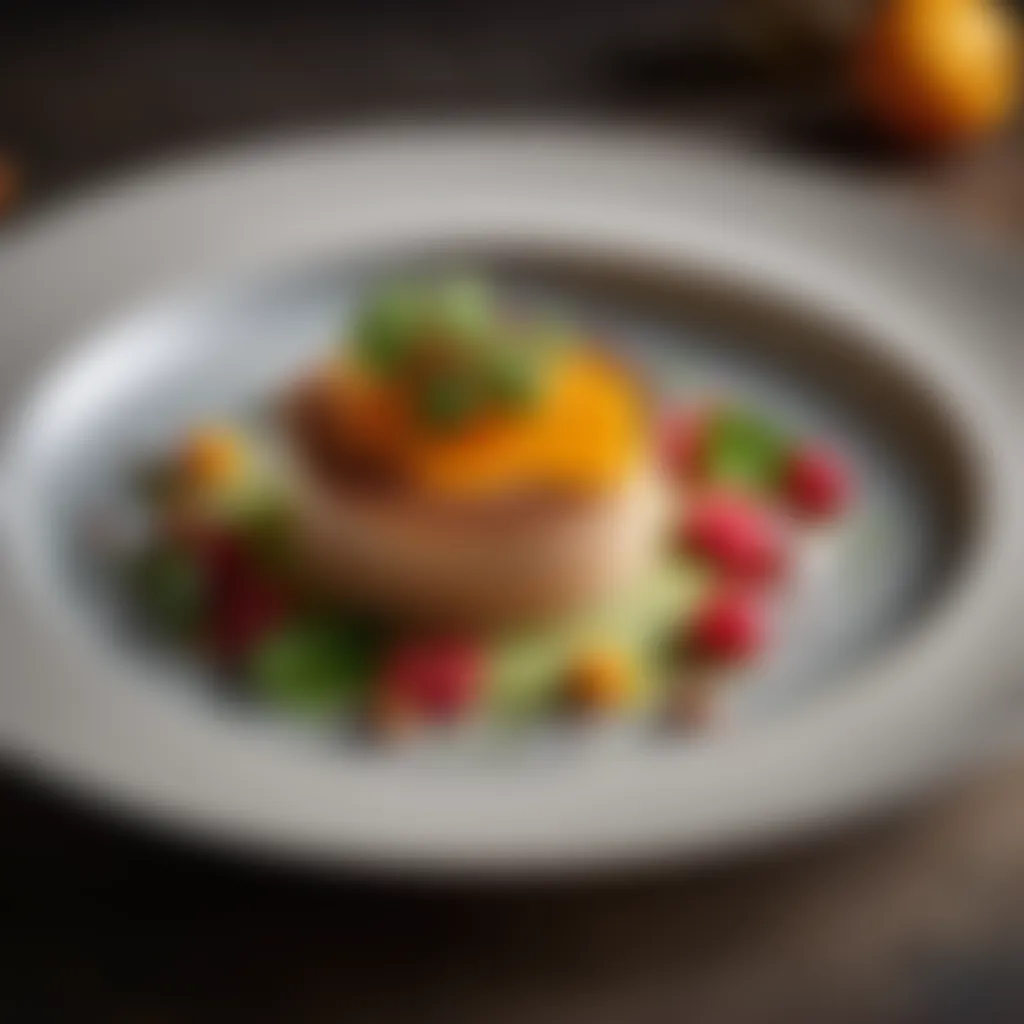
In the realm of gourmet cooking, understanding the importance of time and temperature cannot be overstated. They act as twin pillars, holding up the delicate structure of a perfectly executed dish. When one of these elements is off, the entire foundation can crumble, leading to underwhelming results. Essentially, cooking is not just about following a recipe. It's about mastering the nuances that come with timing and temperature control.
Getting the timing right ensures that proteins are juicy, vegetables retain their crispness, and flavors meld beautifully. On the other hand, temperature control allows for the development of textures and taste, turning a dish from mundane to extraordinary. Too hot, and you risk burning; too cold, and the dish may not cook through.
"Time is the most precious resource in cooking; knowing how to use it elevates your dish from ordinary to gourmet."
Cooking Times: Getting It Right
Every ingredient has its ideal cooking time. For instance, poultry generally requires a longer cooking time than fish. Overcooking can lead to dry, chalky textures while undercooking can pose health risks. Familiarity with these nuances is key. Something as simple as a roasted chicken can vary significantly based on its size, the oven's calibration, and even the altitude at which you're cooking.
Consider these factors when planning:
- Type of Protein: Different proteins have unique cooking times. Steak can be enjoyed rare, while chicken needs to reach an internal temperature of at least 165°F.
- Size of Ingredients: Smaller pieces will cook faster, so chopping your vegetables uniformly can make a difference in timing.
- Method of Cooking: Techniques like grilling or sautéing typically require close attention to cooking times due to the direct heat applied.
To ease the anxiety of timing, some seasoned chefs rely on a simple timer, becoming a crucial tool in the gourmet kitchen. However, one shouldn't just set it and forget it; vigilance is still needed. Always check your dish a few minutes before the time is officially up.
The Science of Temperature Control
Temperature control isn't only about ensuring your stove or oven is set accurately. It's also about understanding how heat interacts with food. The science behind cooking revolves around heat transfer methods: conduction, convection, and radiation. Each has its place: grilling employs radiation, while boiling relies on conduction.
When cooking:
- Low and Slow: Techniques like braising harness low temperatures over extended periods to develop deep flavors.
- Quick and Hot: Searing foods at high temperatures locks in moisture, creating a delicious outer crust without compromising the interior.
Moreover, understanding temperature doneness is a craft that takes time. A meat thermometer can be invaluable, giving an accurate read of internal temperatures, thus ensuring every bite is succulent.
Delving into sous vide cooking also exemplifies perfect temperature control. It allows cooks to maintain a consistent temperature over hours, offering precision unheard of in other methods.
By focusing on the interplay between time and temperature, one can develop an intuitive feel for cooking, leading to dishes that not only taste great but look and feel gourmet. Through practice and patience, mastering these elements will bring any home cook's culinary skills to new heights.
Common Mistakes and How to Avoid Them
Mistakes in the kitchen can be the difference between a gourmet meal and something less than palatable. Understanding common pitfalls when cooking is essential for continuous improvement and culinary success. When embarking on the journey of gourmet cooking, recognizing and addressing common mistakes can elevate your dishes to new heights. This section will explore two significant errors: undercooking and overcooking, along with neglecting seasoning rules, both of which can undermine your hard work in the kitchen.
Undercooking and Overcooking
Knowing when to pull your dish off the heat is a vital skill in the culinary arts. Undercooking not only leads to inedible meals, but it can also pose health risks, especially with meats like chicken or pork. On the other hand, overcooking results in tough and dry textures, stripping away flavors and succulence from the dish.
For example, let’s consider a simple steak. If you remove it from the skillet too early, you might end up with a cold and mushy center that nobody wants to bite into. Conversely, leaving it on for too long can turn that potentially juicy steak into something resembling leather. A typical guideline is to use a meat thermometer, aiming for medium-rare at around 130-135°F (54-57°C). But remember, the steak will continue cooking slightly after being removed from the heat, so taking it off the heat sooner rather than later is key.
Practical tips to avoid these mistakes include:
- Use Timers: Familiarize yourself with cooking times, but also rely on timers to remind you when to check.
- Invest in Thermometers: For both meat and baked goods, instruments like these can be invaluable.
- Visual Cues: Learn to recognize visual signs of doneness for different foods. For example, vegetables should retain a vibrant color while being tender but firm.
"Precision in time can save a dish from disaster - and your guests' appetites!"
Ignoring Seasoning Rules
Another common folly is neglecting seasoning, often mistaken for merely adding salt. While salt is the cornerstone of flavor enhancement, it isn’t the sole player in the seasoning game. Many home cooks forget the magic of herbs, spices, acidity, and even fat. Perfectly cooked food can still fall flat if it lacks sufficient seasoning.
Take a pasta dish, for instance. No matter how well you cook the noodles, if the sauce lacks salt or acidity from lemon juice, it could taste flat and uninteresting. Many chefs emphasize seasoning in layers; season your food while cooking for depth and balance. For example, incorporate salt into your pasta water. It's a simple step that ensures that flavor permeates every bite.
To avoid the trap of bland cooking:
- Taste as You Go: Develop the habit of tasting during different stages of your cooking process. It allows you to adjust flavors early on instead of facing a salty or bland disaster at the end.
- Use Quality Ingredients: Fresh herbs and spices have a more robust flavor than dried versions.
- Balance Flavors: Consider combining flavors; sweet, sour, salty, and bitter can create harmony if balanced correctly.
Continual Learning in Culinary Arts
The culinary world is ever-evolving, and they say if you stop learning, you might as well be baking bricks. In the pursuit of gourmet cooking, continual learning embodies the essence of mastery. Each dish tells a story, and understanding the techniques behind flavors, textures, and presentations can separate the novice from the virtuoso. Keeping your skills sharp is crucial not only for personal satisfaction but also for impressing those whose taste buds you aspire to enchant.
Resources for Skill Enhancement
When it comes to enhancing culinary skills, a wealth of resources awaits ambitious home cooks. Here are some avenues worth exploring:
- Online Courses: Websites such as MasterClass or Skillshare offer extensive lessons from world-renowned chefs. Enrolling in these can deepen your knowledge—whether it's perfecting pasta by Lidia Bastianich or baking with flour from renowned brands like King Arthur.
- Cookbooks: There’s something special about flipping through the pages of a well-loved cookbook. Titles like The Joy of Cooking or Salt, Fat, Acid, Heat offer invaluable techniques and recipes that can redefine your approach to meal preparations.
- YouTube Channels: For those who prefer learning visually, platforms like YouTube are treasure troves. Channels run by top chefs, like Binging with Babish, break down complex recipes into manageable steps, making even gourmet dishes achievable for anyone willing to give it a shot.
- Local Classes: Many culinary schools or community centers host cooking classes. Engaging in hands-on learning allows immediate feedback and fosters a sharing environment with fellow cooking enthusiasts.
Taking advantage of these resources can help you stay ahead of trends in the culinary landscape. Whether you're refining a specific technique or exploring new cuisines, knowing where to look for fresh ideas is half the battle.
Networking within Culinary Communities
Networking is an often-overlooked tool in the chef’s toolkit. Engaging within culinary communities not only fosters learning, but it also cultivates a support system for aspiring cooks. Here are some ways to expand your culinary connections:
- Social Media Groups: Platforms like Facebook or Reddit host various culinary groups where individuals share tips, exchange recipes, and offer advice. These communities can be a springboard for discussions about new techniques or ingredients you may not be familiar with.
- Food Festivals and Events: Attending local food festivals opens doors to meet fellow cooking enthusiasts and seasoned chefs. Participating in workshops or tastings encourages connection, and you may walk away with new friendships and insights.
- Mentorship Opportunities: Seek out chefs who inspire you and ask them about mentoring. Having someone to direct your learning can enhance growth. A conversation over coffee can lead to invaluable advice, or perhaps even opportunities in the kitchen.
- Farmers’ Markets: Regular visits to your local farmers’ market allow you to connect with local producers. Understanding their craft and the ingredients you’re using provides a grounded perspective that enhances your cooking.
Navigating and nurturing these connections can have far-reaching benefits. It not only opens up avenues for learning but enriches your culinary journey as a whole.
"Cook with passion, connect with others, and never stop feeding your curiosity."
By investing in your culinary education and building a network, you empower yourself to not only create gourmet meals but to appreciate them as well.







